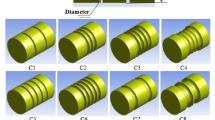Abstract
The present study reports the effect of various flow-forming process parameters and roller geometry on the roughness of flow-formed tubes of commercial pure copper UNS C11000. Thickness reduction ratio, feed rate, angular speed of mandrel, attack angle of roller, roller tip radius, and smooth angle of roller were considered as variable parameters. The effects of these input parameters on the roughness have been critically analyzed using the Taguchi method. Through ANOVA analysis, it has been found that the roller tip radius is the most important parameter affecting roughness followed by thickness reduction ratio. Selection of an optimum combination of variable parameters was performed based on “average of results.” The minimum roughness of 1.37 μm was achieved when the process parameters were set at their optimum values.
Similar content being viewed by others
References
Wong CC, Dean TA, Lin J (2003) A review of spinning, shear forming and flow forming processes. Int J Mach Tools Manuf 43:1419–1435
Xia QX, Cheng XQ, Hu Y, Ruan F (2006) Finite element simulation and experimental investigation on the forming forces of 3D non-axisymmetrical tubes spinning. Int J Mech Sci 48:726–735
Lai MO, Lee KS (1992) Fracture and creep properties of flow-formed tubes. J Mater Process Technol 29:321–330
Molladavoudi HR, Djavanroodi F (2011) Experimental study of thickness reduction effects on mechanical properties and spinning accuracy of aluminum 7075-O, during flow forming. Int J Adv Manuf Technol 52:949–957
Joseph Davidson M, Balasubramanian K, Tagore GRN (2008) Experimental investigation on flow forming of AA6061 alloy—a Taguchi approach. J Mater Process Technol 200:283–287
Joseph Davidson M, Balasubramanian K, Tagore GRN (2008) An experimental study on the quality of flow-formed AA6061 tubes. J Mater Process Technol 203:321–325
Hua FA, Yang YS, Zhang YN, Guo MH, Guo DY, Tong WH, Hu ZQ (2005) Three-dimensional finite element analysis of tube spinning. J Mater Process Technol 168:68–74
Zhan M, Yang H, Zhang JH, Xu YL, Ma F (2007) 3D FEM analysis of influence of roller feed rate on forming force and quality of cone spinning. J Mater Process Technol 187–188:486–491
Roy MJ, Maijer DM, Klassen RJ, Wood JT, Schost E (2010) Analytical solution of the tooling/workpiece contact interface shape during a flow forming operation. J Mater Process Technol 210:1976–1985
Ekinovic S, Begovic E, Plancic I (2012) Influence of flow forming process on cutting force changes in machining of 99.5 % Al workpiece. J Mater Manuf Process 27:791–796
Haghshenas M, Jhaver M, Klassen RJ, Wood JT (2011) Plastic strain distribution during splined-mandrel flow forming. J Mater Des 32:3629–3636
Podder B, Mondal C, Ramesh Kumar K, Yadav DR (2012) Effect of preform heat treatment on the flow formability and mechanical properties of AISI4340 steel. Mater Des 37:174–181
Degarmo EP, Black JT, Kohser RA (2003) Materials and processes in manufacturing, 9th ed. Wiley, p 223, ISBN 0-471-65653-4
George PM, Raghunath BK, Manocha LM, Warrior AM (2004) EDM machining of carbon–carbon composite—a Taguchi approach. J Mater Process Technol 145:66–71
Author information
Authors and Affiliations
Corresponding author
Rights and permissions
About this article
Cite this article
Abedini, A., Rash Ahmadi, S. & Doniavi, A. Roughness optimization of flow-formed tubes using the Taguchi method. Int J Adv Manuf Technol 72, 1009–1019 (2014). https://doi.org/10.1007/s00170-014-5732-8
Received:
Accepted:
Published:
Issue Date:
DOI: https://doi.org/10.1007/s00170-014-5732-8



